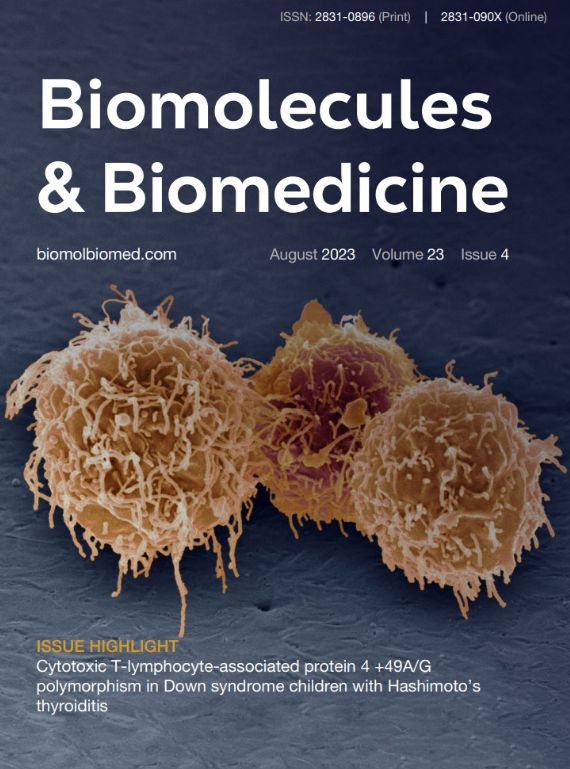Vol.23 No.2
Published: 11.07.2023.
Authors in this issue:
Abdella M Habib, Abdul-Badi Abou-Samra, Aleksandra Aracki Trenkić, Angela Pia Cazzolla, Atalla Hammouda, Benjie Xu, Boris Zec, Cheng Rao, Chenwei Li, Chunyue Feng, Dan Li, Dejan Nesic, Domenico Ciavarella, Dominik Vilímek, Dragan Stojanov, Eleonora Lo Muzio, Elina Beleva, Fang Li, Fei Liu, Feng Wang, Francesca Di Serio, Francesca Spirito, Gaofei Cao, Gordana Petrovic, Haibo Lu, Hao Jiang, Haowen Pang, Hongbing Ma, Hua Yang, Ivanka Nenova, Jan Malůš, Jaroslav Uchytil, Jianguang Shi, Jiayue Shao, Jie Gong, Jie Lian, Jieqiu Zhang, Jieyun Huang, Jin Li, Jun Wang, Justin Clark, Kai Sun, Lichun Wei, Lina Zhao, Ling-Yu Long, Lishuang Wang, Liu Shi, Lorenzo Lo Muzio, Lucia Varraso, Luigi Santacroce, Luka Nikolic, Marek Bužga, Maria Pepe, Mario Dioguardi, Matej Pekař, Mei Shi, Mengyao Zhang, Michele Di Cosola, Milica Radovanović, Milica Živanović, Miroslav Mišić, Mohan Dong, Moustapha Hamdi, Nan Xu, Omran A H Musa, Pavol Holéczy, Petr Kutáč, Qian Jiang, Qian Zhang, Qiong Qing, Quan-Bing Zhang, Ren Wang, Renato Contino, Roberto Lovero, Rui Zhang, Run Zhang, Saif Badran, Sanja Ninic, Sara Alharami, Sasa Popovic, Semir Vranic, Sergej Prijic, Shigao Huang, Shuli Tang, Siqi Liu, Snezana Ristic, Snezhana Stoencheva, Srdjan Pasic, Stasa Krasic, Suhail A Doi, Tanya Deneva, Veronika Horká, Vito Crincoli, Vladislav Vukomanovic, Vuk Milošević, Vukota Radovanović, Weijie Wu, Weiwei Li, Wen-Min Chen, Wudong Wang, Xiangyi Pang, Xiao-Jun Huang, Xiaopeng Yao, Xiaoxiao Liu, Xin Wang, Xinjian Li, Xu Wang, Xuejing Zhong, Ya-Zhen Qin, Yanhui Chen, Ying Zhang, Yingying Jin, Yongrong Zhang, Yuchen Wang, Yun Zhou, Zdeněk Švagera, Zhanet Grudeva-Popova, Zhenjing Jin, Zishan Wang,
Edited by:
Muzafer Mujic & Semir Vranic
Author guidelines
Editorial Policy
4
Issues23
ArticlesYour first address
𝐁𝐢𝐨𝐦𝐨𝐥𝐞𝐜𝐮𝐥𝐞𝐬 𝐚𝐧𝐝 𝐁𝐢𝐨𝐦𝐞𝐝𝐢𝐜𝐢𝐧𝐞 (formerly 𝐁𝐉𝐁𝐌𝐒) is the first address for discoveries in the field of biomedical research.
Become guest editor
Special Issues are led by Guest Editors who are experts in the subject and oversee the editorial process for papers.
Editor’s choice articles
The aim is to provide a snapshot of some of the most exciting work published in the various research areas of the journal.
Archive
See all
Volume 23, Issue 2, 2023
Volume 23, Issue 2, 2023
Volume 15, Issue 1,
Volume 14, Issue 1,
- All Sections
- Biochemistry
- Molecular Biology
- Pathology
- Anatomy
- Translational and Clinical Research
- New and Emerging Medical Entities
16.03.2023.
Research article
Prevention of sarcopenia in patients with obesity after bariatric and metabolic surgery: The effect of programmed training on the muscle tissue and anthropometric functions—A randomized controlled trial (SarxOb study protocol)
Marek Bužga, Matej Pekař, Jaroslav Uchytil, Veronika Horká, Jan Malůš, Dominik Vilímek, Zdeněk Švagera, Petr Kutáč, Pavol Holéczy
16.03.2023.
Research article
Intrinsic resistance and efficacy of immunotherapy in microsatellite instability-high colorectal cancer: A systematic review and meta-analysis
Some patients with microsatellite instability-high colorectal cancer (MSI-H CRC) have shown a poor response to immunotherapy in clinical trials. We investigated the intrinsic resistance to and efficacy of immunotherapy in patients with MSI-H CRC. The PubMed and Web of Science databases were searched using keywords such as “colorectal cancer,” “immunotherapy,” and “clinical experiment.” Random-effects models were used to generate the combined complete response, partial response, stable disease, progressive disease, objective response rate (ORR), disease control rate (DCR), and incidence of adverse events. We then performed a subgroup analysis based on the ORR and incidence of intrinsic resistance. The meta-analysis included seven clinical trials. The incidences of complete response, partial response, stable disease, and progressive disease summarized by the random-effects model were 8%, 37%, 26%, and 25%, respectively. The ORR and DCR were 45% and 71%, respectively. The ORRs of programmed cell death protein 1 inhibitor (anti-PD-1), programmed death ligand 1 inhibitor (anti-PD-L1), and anti-PD-1 combined with cytotoxic T lymphocyte-associated antigen 4 inhibitor (anti-CTLA-4) immunotherapy were 38%, 54%, and 57%, respectively. The ORR of immune checkpoint inhibitors for first- and third-line therapy was 56% and 32%, respectively. Dual-drug immunotherapy significantly reduced the incidence of intrinsic resistance to immunotherapy (12% vs 31%). The incidences of intrinsic resistance to first-line therapy and second-line and later therapy were 29% and 26%, respectively. Approximately 25% of patients with MSI-H CRC had intrinsic resistance to immunotherapy. Anti-PD-1 combined with anti-CTLA-4 significantly increased the ORR, thereby reducing the incidence of intrinsic resistance. Moving immunotherapy into earlier lines of therapy, although not reducing the incidence of intrinsic resistance, can improve the ORR in patients with MSI-H CRC.
Ren Wang, Jie Lian, Xin Wang, Xiangyi Pang, Benjie Xu, Shuli Tang, Jiayue Shao, Haibo Lu
16.03.2023.
Research article
The role of magnetic resonance imaging in the diagnosis and prognosis of dementia
Dementia is a syndrome characterized by multidomain acquired chronic cognitive impairment that has a profound impact on daily life. Neurogenerative diseases such as Alzheimer’s disease or nondegenerative diseases such as vascular dementia are considered to cause dementia. The need for further diagnostic improvement originates from the prevalence of these conditions, especially in developed countries with a predominance of the elderly population. Today, the diagnosis and follow-up of all neurodegenerative diseases cannot be performed without radiological imaging, primarily magnetic resonance imaging (MRI). The introduction of 3T MRI and its modern techniques, such as arterial spin labeling, has enabled better visualization of morphologic changes in dementia. For better diagnosis and follow-up in patients with dementia, various semiquantitative scales have been designed to improve the accuracy of assessment and decrease interobserver variability. Moreover, there is a growing need for MRI in the assessment of novel therapies and their side effects. To better apply MRI findings in the diagnosis of both already developed dementia and its early stages, the aim of this paper is to review the available literature and summarize the specific MRI changes.
Milica Živanović, Aleksandra Aracki Trenkić, Vuk Milošević, Dragan Stojanov, Miroslav Mišić, Milica Radovanović, Vukota Radovanović
16.03.2023.
Research article
Assessment of clinical utility and predictive potential of pre-chemotherapy soluble urokinase plasminogen activator receptor: Observational single center study
Elina Beleva, Snezhana Stoencheva, Tanya Deneva, Ivanka Nenova, Zhanet Grudeva-Popova
16.03.2023.
Research article
Clinical features and outcomes of fusion gene defined adult Ph-negative B-cell precursor acute lymphoblastic leukemia patients: A single institutional report
Kai Sun, Jun Wang, Wen-Min Chen, Nan Xu, Ling-Yu Long, Xu Wang, Hao Jiang, Qian Jiang, Xiao-Jun Huang, Ya-Zhen Qin
16.03.2023.
Research article
Efficacy and safety of PEG-rhG-CSF in preventing chemoradiotherapy-induced neutropenia in patients with locally advanced cervical cancer
Weiwei Li, Mohan Dong, Shigao Huang, Liu Shi, Hua Yang, Ying Zhang, Jie Gong, Mei Shi, Lichun Wei, Lina Zhao
16.03.2023.
Research article
Development and validation of radiomics machine learning model based on contrast-enhanced computed tomography to predict axillary lymph node metastasis in breast cancer
Jieqiu Zhang, Gaofei Cao, Haowen Pang, Jin Li, Xiaopeng Yao
16.03.2023.
Research article
Intensity-modulated radiation therapy for elderly patients with esophageal cancer: Our experience
Dan Li, Xiaoxiao Liu, Yuchen Wang, Yingying Jin, Fang Li, Hongbing Ma











